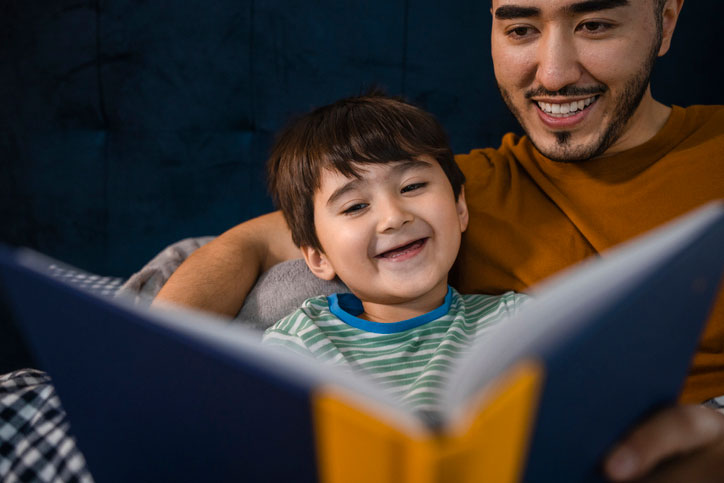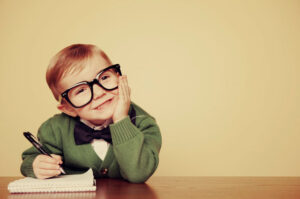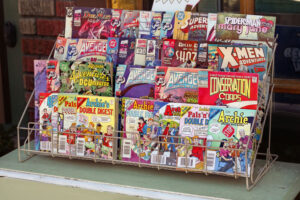Written by Scott Wilson

The very first books you read to children can shape them for a lifetime.
A trip to the Hundred Acre Wood or Neverland can sparks the imagination of new and foreign places, a far cry from the mundane days at home and preschool. Pinocchio’s particular disability and predilection demonstrates the value of honesty in ways that no number of parental lectures could achieve. The journey of Mowgli through the jungles introduces social hierarchy and the importance of family in the most visceral way.
Telling tales to young children is an ancient practice that evolved into an entire category of classic literature and fairy tales.
Modern authors who want to follow in the footsteps of the Brothers Grimm and Lewis Carroll need the special skill of telling entertaining tales in simple language with vivid imagery. Children’s story authors may need a multidisciplinary background, skilled in illustration as well as writing for picture books.
From primers designed to teach the alphabet to meditations on what it would be like to have a giant red dog bigger than your own house, there are plenty of opportunities in creative writing to craft children’s books that draw laughter, forge understanding, and unleash empathy in the very newest readers.
But it takes a special skill and a wildly creative imagination to both invent the sort of stories to grab the attention of children and bring those visions to life. Both of those qualities can come to you with a degree in creative wring.
What Is Children’s Literature?
 No, it’s not great works of literature written by children.
No, it’s not great works of literature written by children.
In general, when people talk about children’s books, they are talking about works aimed at kids under the developmental age of approximately 12 years old. They tend to be short chapter or picture books with limited text to each page, a restricted vocabulary, and short, to-the-point ideas and story lines.
There’s no bright line between young adult and children’s literature. Much depends on the developmental stage of the child. Like any other sort of genre distinction, it’s as much about marketing as it is about the actual audience for the books.
Kid lit can further be grouped by genre or by the target age range of the reader.
Children’s literature is often intended to be a combination of entertaining and instructive.
Kid’s books can be designed either to be read to young children, or to introduce them to reading and the wider world of literature. Because the audience for these works are still building vocabulary and linguistic skills, not only do children’s book authors have to keep their style and word use straightforward, but they also often incorporate strong visual elements in those books.
Children’s books are commonly illustrated and may in fact use visual story-telling as much as the written word. Authors in this genre don’t have to be illustrators, but they do have to be able to think visually and work with other professionals for drawing and illustration.
There are plenty of sub-genres in kid lit, too. Just a few examples include:
First Books
Just what it says on the label, these are books that are designed to be the very first introduction to language and stories for babies or toddlers. Because they are very much for pre-literate children, though, they may actually be more complex and have fewer illustrations since they are designed to be read to the child by an adult.
Picture Books
In the opposite direction are picture books. These are the traditional illustration-focused early readers designed to start kids off with language and words directly. They typically tell the story mainly through the pictures, with the words places carefully to associate meaning. Consequently, they may only have 200 or 300 words through the entire work—but each one is important!

Board Books
Board books are also designed for toddlers and other demographics that may be especially hard on the physical construct of a book. They are printed on thicker cardboard stock that is easier for tiny fingers to flip through and more resistant to tearing, bending, and juice spillage. They can overlap with other genres but are usually matched with picture and early readers.
Educational Books
These children’s books fall more toward the didactic end of the spectrum. They are designed to offer some sort of new information about the world or people in it. They can cover culture, cross-cultural concepts, or weighty matters like death, illness, or how to cope with a new brother or sister in the family.
Early Readers
These books fall just after picture books in the developmental age range of children’s books. They are designed to expand reading skills and vocabulary after the first initial foundations are put in. They are more advanced, with a greater focus on language and story, with illustration offered only as a supporting element. They may be longer than other kinds of children’s books and have more plot and substance, but still are written with direct grammar and basic vocabulary.
Middle Grade
These books are probably the most advanced in the kid lit spectrum, overlapping and blurring together with young adult works. They aimed at kids who are developmentally between 8 and about 13 years old. Consequently, they can be more advanced and may also deal with more advanced subjects—making new friends, fitting in to society, finding your own way in the world apart from your parents.
As you can see, it’s a wide open field with a lot of room for developing your own creativity and ideas. It’s also a genre that is inextricably linked with education. Even in the more entertaining work of kid lit fantasy, new words, new ideas, and new ways of envisioning the world are being passed along. Good children’s authors understand their work on every level.
Are Comic Books Children’s Literature?
 If you are new to the world of children’s literature, you may be surprised at the ferocity of debate over a question you may never have contemplated before: are comic books for kids?
If you are new to the world of children’s literature, you may be surprised at the ferocity of debate over a question you may never have contemplated before: are comic books for kids?
It’s true in the United States, at least, that comics were originally aimed at and primarily read by children. As a format with the tried-and-true combination of pictures and words to tell the tale, they fall right in with picture books as an art form.
But as comic readers grew older, they didn’t necessarily put the books down. And some comic authors began taking on heavier, more mature subjects, weaving complex stories together in a format that began to be called a graphic novel.
It’s that very shift suggest the answer to the debate, though: some comics are clearly meant for kids, while others are not. Within the form, you can find as many different gradations and sub-genres as in traditional formats. And either way, when a child finds something they want to read, smart adults know to encourage them—words open new worlds.
Children’s Books Explore Tough Themes and Ideas in a Straightforward Way
You have to write the book that wants to be written. And if the book will be too difficult for grown-ups, then you write it for children.
~ Madeleine L’Engle
As you might expect from works for children, the issues and themes for kid’s books tend to be pretty straightforward. But that doesn’t mean they are simple. As the works that will be introducing and explaining many of the most challenging concepts in life to children for the first time, kid’s books have to be crafted very carefully. A children’s author needs the skill and sensibilities to talk about tough subjects ranging from death to divorce to sickness.
And, of course, poop.
In every case, it’s a lot to try to pack into a book that may only be 30 pages or so. Children’s books are a vessel carrying their audience on a voyage of discovery, both of the self and of the wider world.
On the other hand, writing for children can be remarkably freeing. Conventions requiring writers conform more or less to accepted consensual reality don’t really apply. Have a talking bear as the main character and no one will bat an eye. Pixies are real and people can take flight with happy thoughts and a little pixie dust sprinkled on them. That’s not sci-fi, it’s kid lit!
J.M. Barrie claims to have added the concept of pixie dust as a necessary ingredient for flight in his Peter Pan stories after a number of children in the real world ended up in hospital after attempting to take off with only happy thoughts to power them.
With the guard rails of reality removed from the course, however, the author of children’s books actually takes on more responsibility. Children are remarkably adept at sniffing out inauthentic stories or behavior. There’s nothing that will lose readers faster than a character behaving in a way that is not true to themselves or the story. A kid lit author has to, in some very real sense, live within the world they are creating.
How to Write a Children’s Book: Creative Writing Degree Programs Give You Exactly the Skills You Need
Sure, it's simple writing for kids…just as simple as bringing them up.
~ Ursula LeGuin
All these talents are tough to pick up on your own. But a degree in creative writing can help you hone many of them, as well as guiding you toward your own innate voice as a children’s author.
These programs come at your skillset for writing pitching children’s books from every direction. The ways they can boost your writing skills and career include helping you in areas such as:
Turning the Creativity Dial up to Eleven Through Reading and Writing
 Exercising your imagination is a vital part of being a creative writer in any genre, and it’s a piece of the program in any creative writing degree. Instructors will throw constant challenges at you that will expand your idea of what is possible in written works, as well as testing the breadth of your own creative capacities.
Exercising your imagination is a vital part of being a creative writer in any genre, and it’s a piece of the program in any creative writing degree. Instructors will throw constant challenges at you that will expand your idea of what is possible in written works, as well as testing the breadth of your own creative capacities.
Additionally, your mind will be fueled with the essential stuff of imagination: a creative writing program comes with prodigious amounts of assigned reading. You’ll be exposed to many different authors in many genres, with different philosophies and styles that will inevitably influence your own.
Developing a Style All Your Own
Children’s authors are also famously inventive in terms of style. There’s nothing that sells a good line to an audience of children like wordplay. Many of the classics of the genre are written in rhyming or other poetic styles.
Not only will the extensive reading that comes with a creative writing degree expose you to all those styles and help you understand your own, but you’ll take courses that unpack the elements of verse and style. Professors will walk you through the operational mechanics of poetics, exploring the structure and form of different styles and their evolution. You’ll find gems and germs of ideas to help you create your own unique literary style to resonate with children.
Exploring the Evolving Psychological Bases of Your Audience
Creative writing degrees aren’t necessarily just all-writing, all-the-time. You’re studying at a university, one stacked up with the most advanced experts in every sort of field under the sun. And you have the opportunity and often the requirement to acquire a full-throated liberal arts education, one expanding your base of knowledge and experience to draw on for story ideas.
This particularly comes into play for children’s book authors through the availability of psychology coursework to help you explore what science has found about the stages of human development. You can take courses that help you unpack not just the thought and growth process of your core audience, but the actual physical and neurological components that go into those processes. That all goes to making you a more incisive, more capable writer of kid lit.
Getting the Essential Feedback to Hone Your Craft
 If writing is an essentially solitary affair, developing your writing skills takes a village. That’s exactly what comes along with a creative writing degree: professors, fellow students, guest lecturers and visiting authors, all of whom have input to help you evolve as a writer.
If writing is an essentially solitary affair, developing your writing skills takes a village. That’s exactly what comes along with a creative writing degree: professors, fellow students, guest lecturers and visiting authors, all of whom have input to help you evolve as a writer.
The constant writing assignments that come along with creative writing studies aren’t just a way to work out your fingers. They also offer legitimate works that you will share with your cohort and receive helpful comments on. Everything from character building to tone to plotting can be improved with feedback. You’ll get plenty of it, and you’ll grow faster than you ever could alone.
Networking With Industry Professionals To Turn a Craft Into a Career
Children’s authors are up against one major challenge that most other writers don’t face: your audience is never going to browse, discover, and buy your books on their own.
One of the biggest benefits on the business side of being a children’s book author is that your audience is constantly renewing itself. A new crop of readers is coming up into your audience every year!
That means a professional network for publication and marketing is an absolute must. And both your classmates and professors can provide invaluable contacts for getting your career launched as they make their own way through the publishing industry. You may get a line on an agent from a professor who knows what they are looking for; a classmate may graduate and end up with a job at a major children’s book imprint and get your manuscript a look it would never have received otherwise.
You’ll also find that the experiences of professors and various guest authors provide valuable insights on how the publishing industry works. You’ll build up your business acumen as a part of being a children’s writer that you probably never considered before.
For Writers of All Stripes, Online Creative Writing Studies Offer New Freedoms With Traditional Rigor
 For many writers of every stripe, online studies are the way to go when pursuing creative writing degrees.
For many writers of every stripe, online studies are the way to go when pursuing creative writing degrees.
Writing, after all, is a necessary solitary affair. As helpful and useful as professors and your fellow students can be in reading, reviewing, brainstorming, and offering suggestions along the way, when you get right down to it it’s just you and the keyboard during the most critical parts of learning to write absorbing children’s literature.
So you can save money and keep your individual flexibility wide open by pursuing your formal creative writing studies online. Keep your day job, or labor in a humble garret atop a mountain with only your inspiration for company—it’s all on the menu.
At the same time, with high-tech connections to your professors and classmates, you still have regular assignments, video chats to check in, and lengthy online dialogs to review. It’s the best of both worlds that has the added bonus of frequently coming at lower cost than an on-campus degree.
Most programs include at least a few on-campus or other in-person meetings, so you’re not just engaged with random faces on a small screen. You have the opportunity to make genuine connections and long-lasting friendships, while still preserving your personal latitude.
Degrees at Every Level Offer a Foot in the Door for Prospective Children’s Book Authors
 No matter what your plans or ambitions as a writer of children’s literature, there is an appropriate program in creative writing to help you along your path. These degrees and certificates in creative writing are offered at every level, giving you an opportunity to get all the advantages of formal creative writing studies no matter what your current background or skill level.
No matter what your plans or ambitions as a writer of children’s literature, there is an appropriate program in creative writing to help you along your path. These degrees and certificates in creative writing are offered at every level, giving you an opportunity to get all the advantages of formal creative writing studies no matter what your current background or skill level.
That starts off with Certificates in Creative Writing. These take a handful of college-level courses and pack them into a tight schedule lasting only a few months. While they don’t offer the full range of training you find in a full degree program, they often come with tightly focused themes that may be just what you need—including specific options such as a Children’s Book Writing Certificate. They can be offered both at the post-secondary and graduate level, tailored to your individual experience level.
A step beyond certificates will take you to a two-year Associate Degree in Creative Writing or a four-year Bachelor’s Degree in Creative Writing. As the first level of degree-granting college studies, these programs are more structured and offer a broader level of education than a certificate. You’ll fulfill expansive general education requirements in areas like math, science, and social studies alongside your English and writing courses. With such broad studies, few options exist specific to writing for children, but you will put in strong foundations in spelling, grammar, plotting, and other essentials for any kind of creative writing career.
The real peak for most professional writers comes with a master’s degree in creative writing. Taking between two and three years to complete, an MFA (Master of Fine Arts) in Creative Writing is considered to be the pinnacle of training in writing. Here, you will find concentrations in areas like the MFA in Writing for Children & Young Adults, or dual degree programs such as a Master of Arts in Children’s Literature plus an MFA in Writing for Children. The level of individual investment in writing prowess that comes with an MFA can’t be beat. Nor can the direct attention of expert, and often widely published, instructors and guest lectures in tight-knit workshops.
There’s also potential to go beyond a master’s, earning a PhD in Creative Writing. But these programs are almost entirely devoted to polishing the research and academic skills needed to teach in the field rather than actively attempting to improve your own writing skills. Still, there are a handful of doctoral-level studies in creative writing that are aimed at producing quality writers rather than quality writing professors.
Each school that offers a creative writing program has a unique culture and conceptual approach to writing education. And the specialties of professors themselves go to shape the program, with their own writing and publication experience offering a preview of their teaching interests and style.
You’ll want to take all of that into account as you look for a school that offers the best shot at launching your own children’s writing career. When you land on the right program, it will put together your inspiration with the right mix of professionalism, expertise, and focus to help you realize your dreams… and spark new dreams in the next generation of readers.





